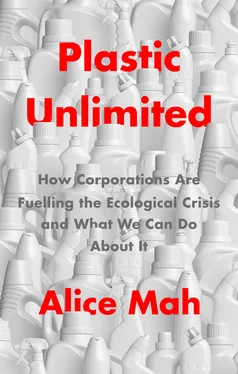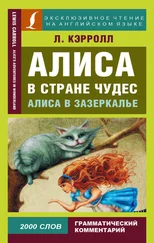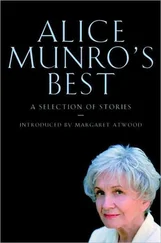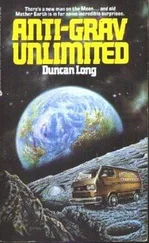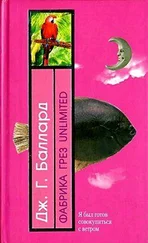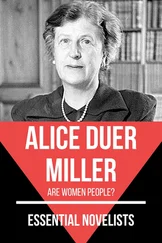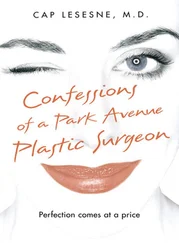After a deluge of depressing facts, the majority of books, films, and reports about the plastics crisis reach the same wilfully hopeful conclusion: that you can make a difference, by reducing your consumption of single-use plastics, recycling and reusing, and, if you’re really keen, going on beach clean-ups and raising community awareness. Some anti-plastic campaigners have taken this mission to heart, writing detailed guidelines about how to live plastic-free within plastic-filled societies. 29Other activists have taken aim at corporations. For example, the environmental NGO Greenpeace, the Break Free From Plastic movement, and the Changing Markets Foundation (which works in partnership with NGOs) have added plastic pollution to their long list of fossil fuel company sins and highlighted the ‘false solutions’ and ‘paper promises’ promoted by industry. 30However, these claims tend to be dismissed by policymakers and the public as ideological, following a predictable script of naming and shaming the ‘top polluters’. This book makes a different kind of intervention. Rather than laying bare the contours of the crisis or lambasting the top polluters, the book asks: how did we get to this point, and what can we do about it? To begin with, where did the drive to make so much plastic come from?
‘I’m glad we have the Tupperware lady with us,’ our instructor said to a room of twenty-five participants, mostly male, at a workshop on petrochemical markets in London. 31The instructor was a former petrochemical manager with decades of experience in the industry, and his material was showing signs of ageing. He fetched some tatty-looking plastic containers from his satchel and laid them out on the corporate boardroom-style table, before launching into a discussion of polyethylene. ‘Tupperware was the first commercial product from polyethylene, and the beginning of home-selling,’ he began. Most of his plastic origin stories started with some kind of anecdote. Another one was about men using epoxy resins to fix their wives’ broken teacups: ‘Guys, this might work at home, but not in industry.’ The ‘Tupperware lady’ and I made eye contact after this comment, and we shook our heads together.
The plastics industry is used to ‘tired old jokes about plastic’, as the industry’s trade magazine referred in 1986 to the famous line from the 1968 film The Graduate : ‘I just want to say one word to you … just one word … plastics. There’s a great future in plastics.’ 32Today, plastics still carry associations with stereotypical images of post-war American life. Other old quotes have resurfaced from this period, acquiring ironic status with the benefit of hindsight. For example, there is the brazen remark from Lloyd Stouffer, the editor of Modern Packaging Magazine , that the ‘future of the industry is in the trash can’. 33This quote is from a speech that Stouffer gave to a plastics industry conference in 1956, where he argued that industry needed to switch from making reusable plastics to making single-use plastics, in order to increase their profits. It echoes the theme of the 1955 photo in Life Magazine captioned ‘Throwaway Living’, which has done rounds on social media, of a family celebrating amidst a swirling array of disposable household products, which promise to cut down on household chores.
One of the most prescient quotes circulating about plastic is by the French cultural theorist Roland Barthes, from his 1957 book Mythologies (translated into English in 1972). Barthes observed that ‘more than a substance, plastic is the very idea of its infinite transformation’, and reached an ominous conclusion: ‘The hierarchy of substances is abolished: a single one replaces them all: the whole world can be plasticized, and even life itself since, we are told, they are beginning to make plastic aortas.’ 34This sounds like both a self-fulfilling prophecy and a dare. Indeed, industry realized the tantalising prospects of playing God with nature, and predictably ignored the Faustian implications. As a plastics executive exclaimed towards the end of the Second World War: ‘[V]irtually nothing was made from plastic and anything could be.’ 35
It’s difficult to imagine the world before it became plasticized. The proliferation of plastics around the planet has been exponential, from the first plastics of the nineteenth century, to 2 million metric tonnes of plastics produced annually in 1950, to 368 million tonnes of annual plastics production in 2019. 36Most histories of plastic begin with the invention of Parkesine in the mid-nineteenth century, a semi-synthetic plastic derived from cellulose that was used as a cheap substitute for ivory and tortoiseshell accessories. 37According to environmental sociologist Rebecca Altman, a less-known story about celluloid is the fact that it ‘accelerated the demand for camphor, a tree product used as a solvent and plasticizer’, due to the rapid expansion of the celluloid market in the late nineteenth century for use in photographic and cinematic film. 38Altman contends that the early history of bioplastics (plastics made from trees and plants) anticipated many of the environmental health and labour injustices that followed. For example, the extraction of tree resins, gums, and latex for rubber and celluloid production led to the violent displacement of Indigenous communities, deforestation, environmental destruction, and workplace hazards. The expression ‘to be gassed’ originated in nineteenth-century vulcanized rubber factories, where low-wage workers suffered from a range of neurological problems due to toxic exposures. 39Viscose rayon, or ‘fake silk’, a fabric derived from cellulose, was also deadly to workers, leading to ‘acute insanity in those it poisoned’. 40
We touched on the early history of rubber at the workshop on petrochemical markets, as part of the C4 (four carbon bonds) butadiene value chain. Our instructor showed us a slide about the first rubber boom from 1879 to 1912, casually observing that ‘natural rubber was Indigenous to Brazil, but all of the rubber trees in Brazil were killed off’. 41Then he described how the British explorer Henry Wickham ‘borrowed’ 70,000 rubber seeds from Brazil, brought them to Kew Gardens in London, and set up plantations in Sri Lanka and Malaysia. However, the violence of this colonial history was only implied, as a taken-for-granted backdrop to the key story behind all plastic origin stories: chemical innovation, exemplified by the scientific achievement of duplicating nature in synthetic form.
The first fully synthetic plastic, Bakelite, was produced in 1907, a thermoset plastic that was hard and strong, but could not be remelted or remoulded. During the polymer science revolution of the 1920s and 1930s in Western Europe and the United States, a vast array of thermoplastics (mouldable at high temperatures) were synthesized for commercial use: polyvinyl chloride (PVC) in 1926; polystyrene in 1930; polyethylene in 1933; nylon in 1935; and polytetrafluoroethylene (later known as Teflon) in 1938. Historians of science and business typically focus on the key inventors and company rivalries during this period of intensive scientific innovation, with the interwar period as a backdrop. 42It was the advent of the Second World War, though, that catapulted plastics onto the world stage of mass consumption.
The Second World War brought unprecedented demands for synthetic rubber, high-octane gasoline (using polymerized chemical additives), parachutes, aircraft components, bazooka barrels, mortar fuses, helmet liners, radar insulation, and a wide range of other military plastics uses. 43Plastics were even crucial for the atom bomb: fluorocarbon plastics (related to polytetrafluoroethylene) were used to contain the volatile gases. 44The war sparked the rapid growth of the petrochemical industry, which began using the by-products of oil (rather than coal) to create plastic resins, the building blocks of plastic products. Massive petrochemical plants sprang up next to oil refineries in the United States and Europe. Anticipating the glut of petrochemical capacity after the war, major chemical companies began to search for new uses for petrochemical products. DuPont started designing prototypes of plastic houseware products that could be marketed to consumers, with the advertising slogan ‘Better Things for Better Living … through Chemistry’. 45
Читать дальше
